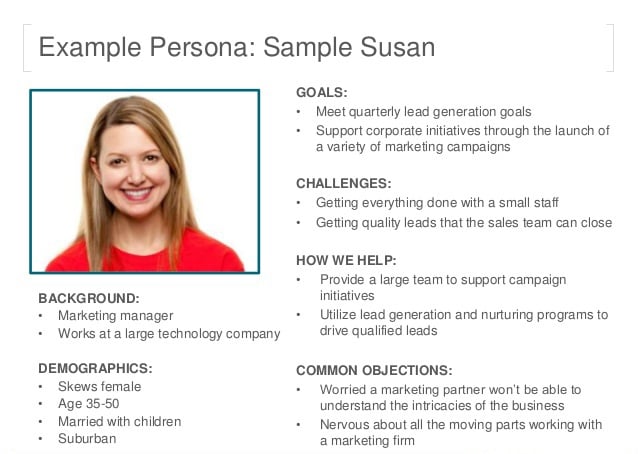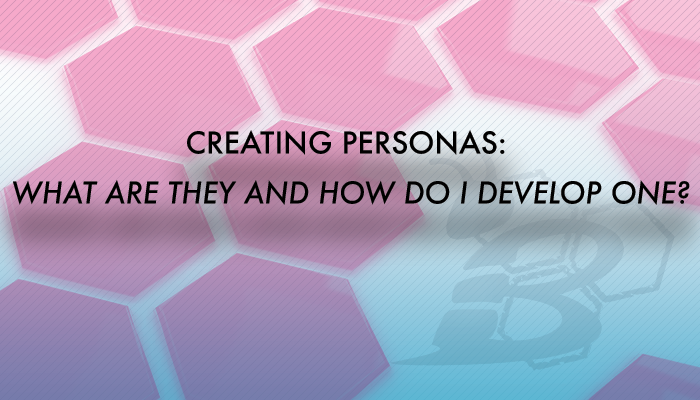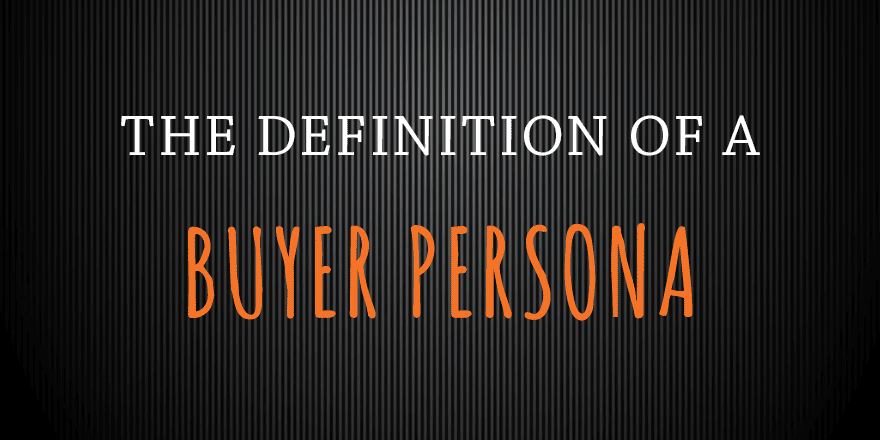One of the biggest benefits of digital marketing is the ability to target and segment your audience. Gone are the days of posting a billboard on I-25, hoping you are reaching your target audience. Instead, say hello to the days of robust targeting, where you can narrow down the types of people you want to talk to not only by age, location, gender, and HHI but also by their interests and behaviors.
Take Facebook, for example. Facebook has some of the best audience targeting capabilities of any platform. If you're looking to find men ages 20-26 who live in Denver, CO, drive a Subaru, ski every weekend in the winter, and love superhero movies...you can find those guys! And then serve an ad to them. Take that, billboard advertising!
All of these increased targeting capabilities are great, but how can you ensure, from a marketing standpoint, that you're going after the right people and developing content and materials that will speak to their needs and wants? Two words for you: buyer personas. Creating personas will help you understand your ideal customers and help make sure that everything you develop falls in line with their wants, needs, goals, and challenges.
Let's talk about what a buyer persona is and how you can develop one for your brand...
What is a buyer persona?
The short answer
In short, a buyer persona is a fictional representation of your ideal customer. Our partners at HubSpot summed it up pretty quickly in this animated gif (we love gifs!):
The long answer
So that's a pretty good, high-level definition of a buyer persona, but what if you want to dig a little deeper and REALLY understand this idea? No problem.
We know that buyer personas are fictional representations of our ideal customer, but simply giving this person a name (Sample Sally, for example) isn't enough. We need to actually go through the motions to give the persona a background and personality as if they were a real, live person. This helps us personify and understand them so that we can better sell to them.
What types of things do we need to think about when we do that? We think about buyer personas in terms of 7 overall categories:
- Background: This should include information about the role at their company, how long they've worked there, and what their personal life is like (are they married? do they have kids?)
- Demographics: Include information about age, gender, household income, and living situation.
- Identifiers: When you come across a person who fits into this persona, how do you know that's them? How can you identify them as the correct persona?
- Goals: What are their primary and secondary goals in relation to your service or offering? For example, if we were selling accounting software, our primary persona might have a primary goal of simplifying their overall accounting process so they can spend less time focusing on accounting tasks like payroll and report running.
- Challenges: What challenges do they face in meeting these goals? For example, again, if we're selling accounting software, one of their challenges might be that they've been sold poor accounting software in the past, which leads them to be skeptical of new solutions.
- What Can We Do?: The "we" in this situation is your company. Think about the persona's goals and challenges and determine how your product or service can help them.
- Common Objections: What are some reasons that this particular persona would not purchase from your company?
EXPERT TIP: Have more than one ideal customer? You're not alone! Most companies will end up with at least three different personas. If you have numerous product lines or service offerings, you might have more. That's ok! They will help you determine what content to serve to which persona when so you're providing each persona with the information most valuable to them.
Example buyer persona
Once you've collected all the pertinent information outlined above. you're ready to put a face and name to your information. Here is an example buyer persona:

Notice how all of the information gathered comes together to create the personification of this customer. Also, notice how the persona has been given a name and a face (in the form of a stock photo). You're almost able to actually see this person as a real, live human, right? That's the beauty of creating a buyer persona. Your ideal customer is no longer this hypothetical being living in the ether somewhere, they are an actual person with actual goals and desires. This lifelike persona is much easier to sell to than some theoretical idea of a customer.
How to develop one
Developing a buyer persona is, as you might imagine based on the above information, a pretty research-heavy process and does not happen overnight. There are two major information sources that go into the development of personas: existing business knowledge and insights and knowledge and insights from actual customers. Let's look at these two categories separately:
- First, let's consider the knowledge and insights that you, as the business owner (or marketing director or whatever your role is), already have. If you are a well-established business, you probably already have a good idea of who your ideal customer is and will be able to answer a lot of the questions listed above. This is great! Sit down and think about your ideal customer. Try not to go too big here. You're not trying to take all of your customers and create one person out of them. You're thinking about who your ideal customer is, the person you would be most happy to have purchasing your products or services. List out everything you know about this person. This information will help you craft those personas.
EXPERT TIP: What if you aren't an established business and don't have any customers yet? No problem, you created your business (or started working there in the start-up phase) for a reason: because the business provides a product or service that you believe in. If you believe in this product or service, you most likely also have an idea of what type of person it's meant for and whom you would like to purchase it. Think of those people during this exercise. - The second thing to consider when developing your personas is insights and knowledge from actual customers (existing or ideal). Your insights are a great starting place, but we also highly recommend talking to some of your current customers (or ideal customers if you aren't an established business yet!) to get some of these questions answered. Your goal is to ask leading questions that will provide you with information to fill in the categories above and ultimately understand who this person is, what they value, what they're looking for, and how you can help them. Getting some of these insights from actual people who are dealing with actual problems your company can help solve will help ensure the personas are realistic and based in fact.
EXPERT TIP: Remember, it's ok to have more than one persona (in fact, it helps if you do) but make sure that your personas are noticeably different so you know how to segment your prospective customers and target content to the correct people.
Developing buyer personas really comes down to knowing who you're talking to and being consistent and thoughtful in giving them exactly what they need, when they need it.
10 Mistakes You're Making With Inbound Marketing
Developing personas is an important step in developing the overall strategy for your inbound marketing. Well-crafted personas can help you determine what content will perform best for which personas in which stage of the buyer's journey. Ready to learn how inbound can help you reach your business goals? Download our free worksheet now.




.png?width=100&height=100&name=The%20Complete%20Guide%20to%20HubSpots%20Prospecting%20Agent%20(2025%20Edition).png)

.png?width=100&height=100&name=Why%20Were%20Not%20a%20Marketing%20Agency%20(And%20What%20That%20Means%20for%20Your%20Growth).png)